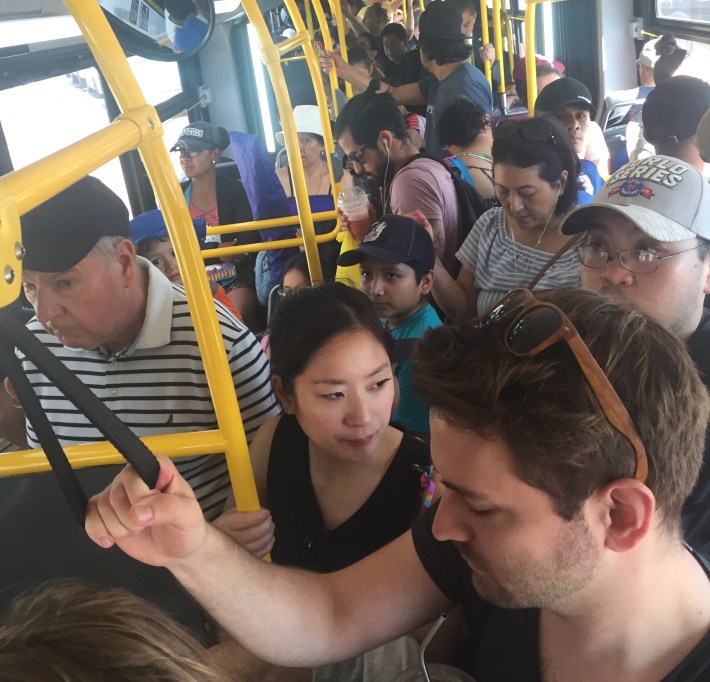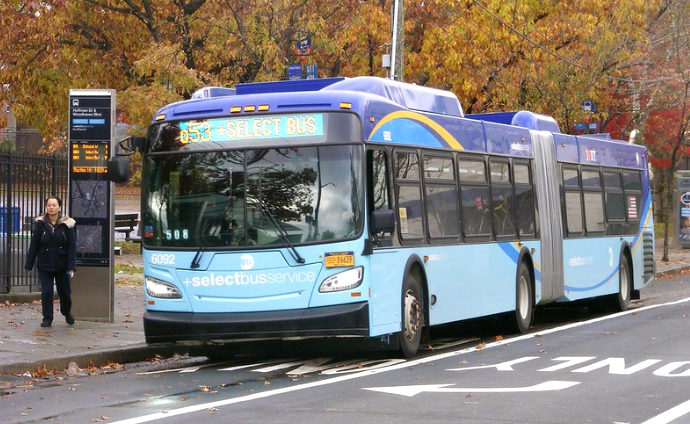The MTA's first wholesale redesign of the Queens bus network in more than 100 years envisions shorter, less circuitous routes; specialized service categories for bus lines; and "priority corridors" where MTA and DOT street improvements will boost bus speeds — an ambitious overhaul that the agency hopes will lead to faster trips for the borough's almost 700,000 daily bus riders.
The Queens redesign, which follows less-ambitious redesigns in Staten Island and the Bronx, seeks to untangle the borough's bus network through straighter bus routes and a reduction in the number of lines from 82 to 77. The redesign involved dozens of public meetings and direct contact with thousands of riders on buses, plus almost 2,000 customer surveys that were submitted online in an attempt to rebuild the entire bus network from scratch.
"We are very excited about this draft plan for Queens buses because it is a true reimagination of the routes that incorporates the earned knowledge of customers, our ground personnel and operations staff to create a new foundation of bus service in Queens," New York City Transit head Andy Byford said.
The draft plan seeks to simplify the sprawling, tangled Queens bus map by combining routes to reduce redundancies and by dividing bus service into categories (each proposed route is currently assigned a "QT" prefix to separate it from from the existing "Q" routes):
- routes with far-apart stops that serve high-demand areas and provide inter-borough connections will only stop in high-density mixed-use areas (such as the proposed QT54, operating between Jamaica/170th Street and the Williamsburg Bridge Plaza in Brooklyn).
- routes that provide rapid service across the borough (for example, the QT58 between Flushing/Main Street Station and Ridgewood Terminal) will have fewer bus stops than the current routes.
- neighborhood routes will configure stops more closely. For example, the proposed QT13 Jamaica-Far Rockaway route will have stops that are roughly 1,300 feet apart — which is more than the current average, but less than other redrawn lines.
- routes that will stop often in subway deserts, and become pseudo-express buses as they travel to and from subway connections (such as the QT48 Willets Point Boulevard route between Fort Totten and Flushing/Main Street Station).
(The draft plan does not include exact bus stop locations or exact schedules for the proposed lines because those decisions will be made after public feedback on the plan.)
The MTA plan also recommends a series of 21 "bus-priority corridors," key roadways across Queens that will be reconfigured to favor buses over cars. The authority said that the redesign's final draft would enumerate proposed New York City Department of Transportation improvements in the corridors, including bus lanes, busways and "transit-signal priority," a traffic-signal treatment that extends green lights or shortens red lights for buses.
Eastern Queens will get the bulk of the subway-desert routes, with a series of bus lines that would start with close-together stops that would then widen in order to speed the buses as they neared transit hubs such as Flushing and Jamaica. The idea won praise from TransitCenter spokesman Ben Fried, who said that "Eastern Queens neighborhoods like Hollis and Laurelton stand to especially benefit" from the redesign's subway-desert proposal.
Queens buses now move at an average speed of 8.7 miles per hour, the second-fastest rate of any city buses. Even so, speeds are down from the 9 miles per hour in 2015, and the decline in speeds has tracked with a decline in ridership. In 2014, Queens buses served 728,872 people, but customers fell to 689,702 by 2019. "On-time performance," also fell 12 percent from 2014 to 2018.

The plans also call for "rebalancing" bus stops — spacing them further apart — along many lines in order to eliminate the need for a bus to pull in and out of traffic so frequently. The average distance between bus stops in Queens, now 850 feet apart, would widen to 1,400 feet under the plan. Eliminating stops is always controversial because people — especially those with more-limited mobility — can come to rely on certain locations, but it is key to speeding up service.
"Buses spend 20 percent of their time at bus stops, which slows down the bus," said Riders Alliance spokesman Danny Pearlstein. "Bus stops need to change for bus service to get better."
The redesign effort represents an important milestone to be celebrated, Pearlstein added, because the old network was formed on outdated trolley and private bus lines that did not change as population and job centers changed. The redesign, Pearlstein said, seriously grapples with the question, "How can we get working-class New Yorkers around better?"
Advocates and bus riders nevertheless dinged aspects of the draft plan. Beach lovers, in particular, objected to the consolidation of the Q52 SBS and the Q53 SBS. The lines run from Jackson Heights down Woodhaven Boulevard into the Rockaways, and end at either Rockaway Park (Q53) on the west side of the peninsula or Arverne on the east side. Under the draft plan, the lines have been consolidated into a single route that runs from Elmhurst to Arverne, with no service to western Rockaway.
The Q53 is particularly popular — and jammed — on summer weekends.
galaxy brain take: to make this more okay, do what should have been done years ago and convert Woodhaven to an express station
— Uday Schultz 🚰 (@A320Lga) December 31, 2019
The bus “REDESIGN” is a front for service cuts! #Q53 is good bus w/frequent service that goes to Elmhurst, Jackson Heights & Woodside from Beach 116th. NYCTBUS will “modify” service & #Q53 will no longer exist!
— JimRockaway (@JimRockaway) December 31, 2019
Check your bus! We have to fight this.https://t.co/4C5nz9pg7S pic.twitter.com/ZxSvePMoy5
Last summer, I switch from bike to Q53 to get from Jackson Heights to Rockaway, because I'd like to not die on Cross Bay Blvd where @NYC_DOT abandons us to the wolfs. Now @NYCTBus has abandoned us too. I guess summer 2020 will be either no beach or biking with assault vehicles. https://t.co/aqRNn6ml0Z
— Radlerkönigin (@radlerkoenigin) January 3, 2020
In a money-saving move, the MTA chose to eliminate Sunday express buses, which the agency said had low ridership. But critics said that the elimination didn't make sense if express buses still ran on Saturdays.
"No more Sunday express bus service," tweeted Cap'n Transit. "We're not a Christian town!"
In addition, critics said the elimination of certain express routes meant that many trips would take longer on a bus than in a car — and so would encourage driving – or would even longer under the new and allegedly improved routes. The plan was also knocked for decreasing the number of buses that connect to the Roosevelt Av/74th Street E/F/M/R/7 stop, and for giving multiple routes low service frequencies despite the simplified and shorter lines.
Okay, the Queens Bus Network Redesign Proposal is out, h/t @TransitNinja205 @joby_jacob for the link! It may be good overall, but there are a few red flags. The first is no more Sunday express bus service. This is bullshit. We're not a Christian town!https://t.co/79KM5cRbBR pic.twitter.com/q9N1wgCgec
— Cap'n Transit (@capntransit) December 31, 2019
Let's assume that express buses no longer exist. Jane lives in Glen Oaks and wants to get to Little Neck Station. The Q36 (a 7 min walk) comes every 15 mins - but the QT87 will run every 20 mins but she has to walk 30 mins to get there! Jane's driving folks! pic.twitter.com/a69Dsr32DS
— ജോബി @JobyJacob@mastodon.social (@joby_jacob) December 31, 2019
3 - If a goal is to improve bus connections to the subway, why does the plan decrease the bus lines connecting with the E,F,M,R (and 7) at Roosevelt Ave/74th Street? In fact, only three commuter buses will connect with this station, which is the second-busiest Queens station.
— Christopher Goeken (@chrisgoeken) January 2, 2020
After skimming through the entire plan, that’s my biggest gripe with it. The route alignment redesigns are great, but the headways for most routes are pretty bad. There are too many routes where at peak is >= 15 mins and off-peak >= 30 mins.
— Sunny Ng (@_blahblahblah) December 31, 2019
MTA spokeswoman Amanda Kwan said that full proposed schedules would be available next week so that riders can plot out specific trips based on the schedules and routes proposed in the redesign.
Ultimately, Fried said, the draft plan had "a lot worth fighting for" in it. Changes are sure to be made though as the MTA gets feedback through early 2020 at a series of workshops and online before the final plan is released halfway into 2020 and implemented in 2021.






